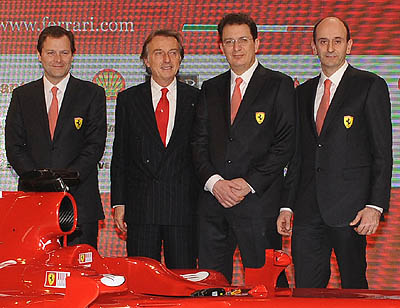


28/01/2010
NEWS STORY
 |
This afternoon, Ferrari's senior technicians met the media to discuss the F10's technical details and main characteristics
The first question was about one of the unknown factors in 2010, tyres. Aldo Costa (above left), the team's technical director, said: "As far as the tyres are concerned it hasn't happened very often that we come to the first test with a new car with tyres we've never seen before, never used and never tested. This year we're racing after only four tests. We're confident that Bridgestone has done some excellent work, but with changing the compound four tests might not be enough."
"We also worked to speed up the change of tyres," added chief designer, Nikolas Tombazis (above third from left). "In recent years the refuelling limited us, but this year this is different, so we worked, regarding the pit stop, on the change of tyres."
Later, there were questions regarding safety, still referring to the tyres, which are now different in size and with different compounds. An Italian journalist asked: If there was a safety problem, would you ask the FIA for more test sessions?
"Bridgestone is very interested in the tyre tests and they will analyse their behaviour after the long runs," said Costa. "More weight on the tyres has changed the single-seaters structure; and it's very unusual to start in that sense."
Asked why he believes the F10 will be better than its predecessor, Costa said: "We analysed the reasons why we weren't strong enough last year, car, organisation, approach," said Costa. "The development data regarding aerodynamics, simulator and test stand makes us think that lots of development has been done."
Tombazis was asked about the aerodynamics and the fundamental role the weight displacement plays - is it always the best solution to have more downforce in the back? "In aerodynamics rear downforce is harder to find. We're always looking to improve the car's efficiency to improve the performance. As far as the car's set up is concerned we do have some doubts about it, due to the fact that we haven't used the new tyres yet. The KERS is gone, but the minimum weight has been raised. There's more ballast to adjust the weight in case there were problems with the distribution.
"Let's get back to the KERS for a second," he continued. "In reality last year it worked very well, although it did create a certain deficit on the car's overall package. That fact that it's gone made us lose a performance delta, but by space-saving we gained what we lost with the KERS. The volume of the tank is much bigger than of the KERS."
Luca Marmorini (above right), who is debuting as the Head of Engines and Electronics, was asked how it is possible to recover performance when engines can no longer be modified.
"Nobody ever went beyond a certain level with the engines," he said. "This year we won't have any refuelling and the mechanics want to use the engines in ranges they hadn't thought of before. That's an interesting challenge in terms of performance research in the light of the 2010 rules. The mechanic's intervention can be found in the engine's use, because the rules don't allow modifications of internal parts, so it will be really interesting to see the results."
In terms of the decision to 'interrupt' development of the 2009 car to start working on the F10, Costa said: "We think that it was necessary to interrupt working on the F60's development, because we didn't have the possibility to win the championship. Now we're trying to forget last year and concentrate on 2010. But the decision was strategic, agreed on by the technicians and Stefano Domenicali."